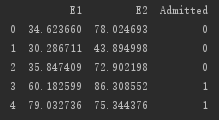案例:
案例:
建立一个逻辑回归模型预测一个学生是否可以被录取。
根据两次考试的结果来决定每个申请人的录取机会,有以前申请人的历史数据,用它作为逻辑回归的训练集,建立一
个分类模型,根据考试成绩估计入学概率。
#准备工作,导入包
import numpy as np
import pandas as pd
import matplotlib.pyplot as plt
#读取文件
import os
path = 'data' +os.sep+'LogReg_data.txt'
pdData = pd.read_csv(path,header=None,names=['E1','E2','Admitted'])
pdData.head()
pdData.shape
### os.sep 根据你所处的平台,自动地采用相应的分割符号
### head() 默认输出五行
#数据可视化展示
positive = pdData[pdData['Admitted']==1]
negative = pdData[pdData['Admitted']==0]
fig,ax = plt.subplots(figsize=(10,5))
ax.scatter( positive['E1'],positive['E2'],c='r',marker='o', label='Admitted' )
ax.scatter( negative['E1'],positive['E2'],c='b',marker='x', label='Not Admitted')
ax.set_xlabel('E1 sources')
ax.set_ylabel('E2 sources')
plt.show()
The logistic regression
目标:建立分类器(求解出三个参数012)
设定阈值,根据阈值判断录取结果
要完成的模块
sigmod:映射到概率的函数
model:返回预测结果值
cost:根据参数计算损失
gradient:计算每个参数的梯度方向
descent:进行参数更新
accuracy:计算精度
sigmod函数:
def sigmoid(Z):
return 1/(1 + np.exp(-z))
模型函数:
def model(X,theta):
return sigmoid(np.dot(X,theta.T))
pdData.insert(0,'Ones',1) #首列插入全是1的值
orig_data = pdData.as_matrix() #数据格式转化为矩阵
cols = orig_data.shape[1]
X=orig_data[:,0:cols-1] #提取特征
y =orig_data[:,cols-1:cols] #提取标签
theta = np.zeros([1,3]) #初始化三个参数
#计算损失
def cost(X,y,theta):
left = np.multiply(-y,np.log(model(X,theta)))
right = np.multiply(1-y,np.log(1-model(X,theta)))
return np.sum(left - right)/(len(X)) #根据似然函数的目标函数列式
#计算梯度
def gradient(X,y,theta):
grad = np.zeros(theta.shape) #初始化梯度参数
error = (model(X,theta)-y).ravel()
for j in range(len( theta.ravel()) ): #遍历对每一个参数求偏导
term = np.multiply(error,X[:,j])
grad[0,j] = np.sum(term)/len(X)
return grad
STOP_ITER = 0 #根据迭代次数终止
STOP_COST = 1 #根据损失值终止
STOP_GRAD = 2 #根据梯度终止
def stopCriterion(type,value,threshold):
#设定三种不同的策略
if type == STOP_ITER: return value>threshold #threshold 指定阈值
elif type == STOP_COST: return abs(value[-1]-value[-2])<threshold
elif type == STOP_GRAD: return np.linalg.norm(value)<threshold
import numpy.random
#洗牌
def shuffleData(data):
np.random.shuffle(data)
cols = data.shape[1]
X = data[:, 0:cols-1]
y = data[:, cols-1: ]
return X,y
import time
def descent(data, theta, batchSize,stopType,thresh,alpha):
#梯度下降求解
init_time = time.time()
i =0 #迭代次数
k=0 # batch
X,y = shuffleData(data)
grad = np.zeros(theta.shape) #计算的梯度
costs = [cost(X,y,theta)]
while True:
grad = gradient(X[k:k+batchSize],y[k:k+batchSize],theta)
k += batchSize #取batch数量个数据
if k>= n:
k=0
X,y = shuffleData(data) #重新洗牌
theta = theta - alpha*grad #参数更新
costs.append(cost(X,y,theta)) #计算新的损失
i+=1
if stopType == STOP_ITER: value = i
elif stopType == STOP_COST: value = costs
elif stopType == STOP_GRAD: value = grad
if stopCriterion(stopType,value,thresh):break
return theta,i-1,costs,grad,time.time() - init_time
def runExpe(data,theta,batchSize,stopSize,thresh,alpha):
theta,iter,costs,grad,dur = descent(data,theda,batchSize,stopType,thresh,alpha)
name = "Original" if (data[:,1]>2).sum()>1 else "Scaled"
name +="data - learning rate:{} -".format(alpha)
if batchSize ==n:strDescType = "Gradient"
elif batchSize == 1:strDescType = "Stochastic"
else:strDescType = "Mini-batch({ })".format(batchSize)
name += strDescType+"descent-Stop:"
if stopType == STOP_ITER:strStop="{} iterations".format(thresh)
elif stopType ==STOP_COST:strStop="costs change <{}".format(thresh)
else :strStop ="gradient norm<{}".format(thresh)
name +=strStop
print("")
fig,ax = plt.subplots(figsize=(12,4))
ax.plot(np.arange(len(costs)),costs,'r')
ax.set_xlabel('Iterations')
ax.set_ylabel('Cost')
ax.set_title(name.upper()+' -Error vs.Iteration')
return theta
#精度:
def predict(X,theta):
return [1 if x >=0.5 else 0 for x in model(X,theta)]
scaled_X = scaled_data[:, :3]
y = scaled_data[:,3]
predictions = predict(scaled_X,theta)
correct = [1 if ((a == 1 and b==1) or (a==0 and b==0)) else 0 for(a,b) in zip(predictions,y)]
accuracy = (sum(map(int,correct))%len(correct) )
print('accuracy={0}%'.format(accuracy))
























 2546
2546











 被折叠的 条评论
为什么被折叠?
被折叠的 条评论
为什么被折叠?








